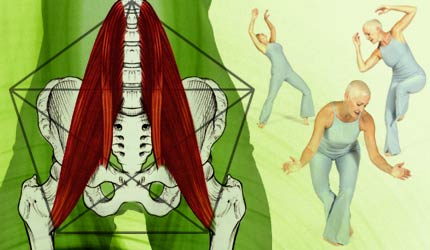

Did you know that your body is designed to realign and re-pattern itself? Did you also know that with a little conscious attention you could help the re-patterning move along more quickly? Each time you sit, stand, and move, you can help your body reestablish balance and comfort. How? By listening to the voice of your psoas muscle. Many experts, including the renowned Ida Rolf, say the psoas muscle is the most important muscle in the body.
The psoas muscle is a major muscle found in your groin. It creates a bridge between your upper body and lower body and plays an important role in providing you with mobility and stability. As you see in the illustration, this muscle is attached in your lower body at the inside of your thighbone and in the upper body at the lower six vertebrae of your thoracic and lumbar spine. Why is this muscle so important? Because the psoas muscle affects the ability of your legs and spine to move freely. Additionally, it is responsible for maintaining stability in your core. Proper strength and flexibility in the psoas muscle create the kind of support you need to be graceful, agile and powerful. Keep your psoas muscle strong, flexible, balanced, and well toned, and your upper body and lower body will move with ease, and you’ll sense a whole new freedom in the vertical alignment of your spine elegantly hanging down and extending up.
In Nia, we teach you to make a conscious mental connection to the psoas muscle by seeking the sensation of this muscle actively involved as you move. For example, you consciously and personally train yourself to sense the psoas muscle lengthen as you rise and soften as you sink. You change the direction of your feet, altering between toes in-out-parallel to tone your psoas muscle and keep it dynamic, meaning not too tight and not too loose. This is the goal.